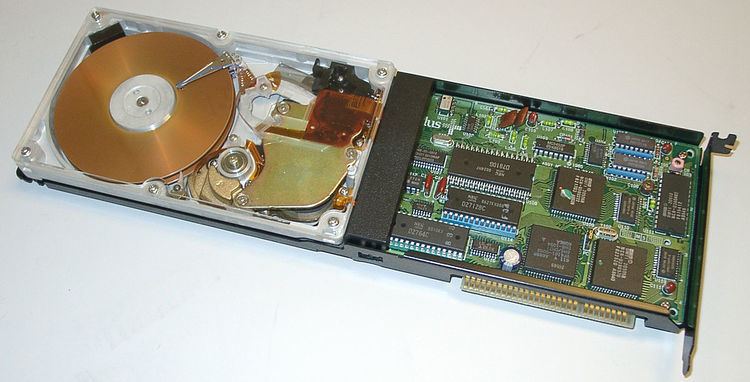 | ||
Hardcard is the genericized trademark for a hard disk drive, disk controller, and host adapter on an expansion card for a personal computer.
Contents

Typically a hard disk drive (HDD) installs into a drive bay; cables connect the drive to a host adapter and power source. If the personal computer lacks an available bus on a compatible host adapter, then one may have to install an adapter into an expansion slot. The Hardcard supplies its own host adapter, and doesn't require an empty drive bay.

Plus Development, a subsidiary of Quantum Corporation, developed the first ISA Hardcard, and released it in October 1985. By June 1986, 28 of Plus Development's competitors were producing similar products. The term has been used generically to refer to any hard disk on a card.

History
Quantum Corporation formed the Plus Development subsidiary in 1983. Plus Development invested their efforts in developing a hard disk drive that the average computer owner could install easily without much technical knowledge.
By 1985, Plus Development had engineered their first Hardcard; it had a 10 megabyte (MB) capacity; its suggested retail price was $1,095. In the mid-1980s, hard drives were as small as 1.6 inches tall, but in order to fit into a single ISA PC card expansion slot a custom one-inch thick hard drive had to be designed. Having spent $15 million on the project, Plus Development started shipping Hardcard in October 1985, and trademarked the Hardcard brand in 1988.
The Hardcard provided the computer industry with the first one-inch-thick HDD, but it was an interface and form factor only compatible with the full length card slot of the ISA bus first introduced with the IBM PC. As such it had a thicker head disk assembly than the subsequently introduced 1-inch high standard form factor 3½-inch HDDs.
While sources inside the company during the launch of Hardcard claim it was the first HDD controller integrated into the drive printed circuit board, Xebec, a HDD controller manufacturer in the early 1980s, had already done that with their Owl product around August 1984. It was a complete 5.25 inch half-height HDD with an integrated controller and drive electronics on the same printed circuit board with a SASI interface.
Plus Development's Hardcard products
After the introduction of Hardcard, Plus Development continued working on higher capacity hard drives in the same form factor of the first Hardcard. The brand name became so widely known the name was continued through the follow on products.
The Hardcard II and Hardcard II XL were advertised with effective access times as a result of the disk cache. The Hardcard II listed both times, but Hardcard II XL only listed the effective access time. The Hardcard EZ line returned to listing the access times without the benefit of the cache.
All Hardcard products up to and including Hardcard II XL were produced under the Plus Development name. The Hardcard EZ was released under the Quantum name after Quantum absorbed the wholly owned subsidiary Plus Development.
Competition
Within one year of the Plus Development introduction of Hardcard, 28 companies had released similar products. At that time, all of the other products were using a standard hard drive with a 1.6-inch height forcing the card to hang over the adjacent PC slot. The hard drive was located on the opposite side away from the connector sometimes enabling a short half-length expansion card to be installed in the adjacent slot. These hard drive cards were usually described as occupying 1.5 expansion slots. Below are some of companies and product names with a similar product to the Plus Hardcard.
Tandy 1000
In 1985, Tandy introduced the Tandy 1000. Tandy offered its own proprietary hard card for $799 for 20meg. Only the Tandy 1000 that had an 8-bit slot could accommodate a hard card, preserving the drive bays for disk drives and cd-rom's. The 8-bit slots were electronically compatible slots, but the physical length was only 10 1/2 inch long instead of 13 inches long. As a result many hard drive cards such as Plus development would not fit within the size reduced case, and hence were not compatible. Thus hard cards had to be certified as Tandy compatible to see if they work in a Tandy 1000 model such as the sx, tx, sl, tl series. It is possible to get a Plus development hard card to work on a tandy 1000, provided that the plastic case is completely removed and metal frame is cut, to allow the longer card 13" card to fit.
A hard card has to be no longer than 10" inches long, and 8 bit to work in a Tandy 1000 computer, and usually has to be in slot 1, because of the overhang. Unless one is willing to remove the case cover and modify the metal frame. The Tandy 1000 60 watt power supply is also under powered, so a lower powered hard card is preferable.
